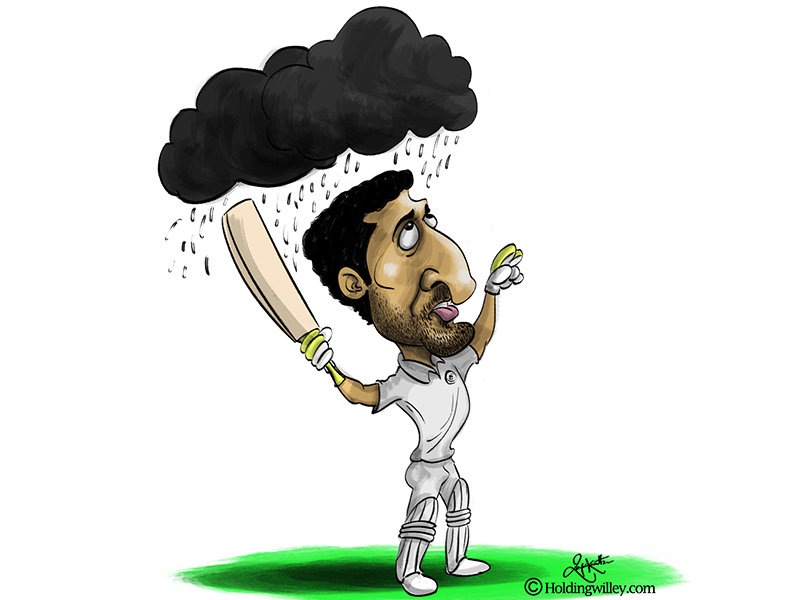 Karun Nair can regard himself as one of the unluckiest cricketers in the modern era. His rise through the domestic circuit was filled with the hardships and challenges that befall every aspiring cricketer. By piling on consistent runs in First-Class cricket, there came a time when the selectors could no longer overlook his efforts.
Karun Nair can regard himself as one of the unluckiest cricketers in the modern era. His rise through the domestic circuit was filled with the hardships and challenges that befall every aspiring cricketer. By piling on consistent runs in First-Class cricket, there came a time when the selectors could no longer overlook his efforts.
When England came calling in the winter of 2016/17, Nair was presented with an ideal opportunity to make his mark after an injury to Ajinkya Rahane opened up a place in the side. Grabbing this chance, he broke a number of records to smash an unbeaten 303* at Chennai, becoming only the second Indian after Virender Sehwag to have achieved the feat of a triple ton.
Just when it seemed that the Karnataka player had edged Rahane out of the playing XI, Virat Kohli cleared the air by stating that when Rahane regained fitness, he would walk into the final squad, with Nair having to make way for the senior pro. The policy - widely followed by the Australian cricket team where a replacement is substituted by the regular even if he performs to his full potential - was seen as a courageous step by the Indian skipper, who was keen to give enough chances to his players before dropping them from the side.
Rahane hence returned to the international fold against Bangladesh, scoring 82 runs at Hyderabad. Nair played the series against Australia though, scoring 26, 0, 23 and 5 in three games. It was also his last appearance in Test cricket. Yes, he failed to get going, but dropping him a few games after his triple century was unfair. Even Kohli had a poor run against the former world number 1 side, but instead of giving Nair a consistent run, so he could reach his potential again, he was overlooked for the subsequent games and series.
Instead, Rohit Sharma – who has often struggled in whites – was picked ahead of Rahane when the latter suffered a poor run of form. On the back of a hundred against a lacklustre Sri Lankan unit in Tests, Rohit was picked to tour South Africa. Nair, who had scored 153 in Ranji cricket just days before the team going to the Rainbow Nation was announced, was ignored.
Rohit’s dazzling form in white-ball cricket before the Tests in South Africa further solidified his spot in the Test team, and he was even picked over Rahane for the first two matches in Africa. Picking a player in one format based on his exploits in another format proved a poor move, as Rohit looked uncomfortable against the swinging and bouncy conditions.
Choosing a technically inept player in Tests when a better choice was available (both Rahane and Nair would have been better picks), was a major reason for the series loss.
With Rohit not clicking in Tests, the selectors turned to Nair once again for the tour to England, and it was hoped that the player could enjoy an extended run this time around. After trying out various team combinations, the management decided to drop Hardik Pandya for the fifth game in England. They preferred going in with an extra batsman in the match, considering the poor form of the batting unit in the series till then.
Outside of the management, everyone assumed that Nair, who had been with the side from the beginning of the tour, would be selected. But in a surprise move, Hanuma Vihari was given his Test debut at The Oval.
Why then, was Nair in the side if the management had no intention of playing him? Nair, with a First class average of 51.09, has churned out the runs asked of him. Why is he being constantly shoved aside, whilst new and upcoming players take his place? And, more importantly, why did no member of the management have a word with Nair over what is expected from him, so that he could work on his flaws and return a better player?
Nair was frank in saying that no one from the management, either the coaching staff or the selectors, had given him a reason for the puzzling treatment in England. No one even approached him when he was dropped for the series against West Indies, which could have been an ideal opportunity for Nair to once again show his worth in the absence of a few senior members.
Instead, Mayank Agarwal, who has been racking up huge runs in domestic cricket, was picked. While the sentiment behind Agarwal’s selection is worthy of applause, it is befuddling to see Nair being omitted. He has not even received enough chances to fail. If he had, it would have put an end to the innumerable questions that keep popping up.
The treatment of Nair shows how miscommunication is rampant in Indian cricket. This is not only unfair, but also unfortunate for the hordes of young cricketers who keep pitching in with consistent performances in the hope of an extended run with the Indian national side.